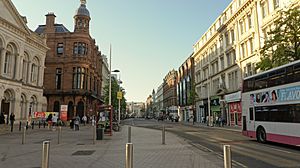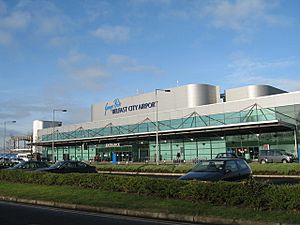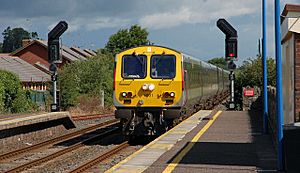Economy of Northern Ireland facts for kids

Belfast City Centre
|
|
| Currency | Pound sterling (£) |
|---|---|
| 1 April to 31 March | |
| Statistics | |
| Population | 1,910,543 (2022) |
| GDP | £56.7 billion (2022) |
|
GDP per capita
|
£29,674 (2022) |
|
Labour force
|
879,000 / 71.8% in employment (Jan–Mar 2024) |
|
Labour force by occupation
|
List
23.9% Professional
12.0% Administrative and secretarial 11.9% Skilled trades 10.8% Associate professional 10.3% Caring, leisure and other service 9.3% Elementary occupations 7.9% Sales and customer service 7.0% Managers, directors and senior officials 6.1% Process plant and machine operatives (Jan–Dec 2023) |
| Unemployment | 19,000 / 2.1% (Jan–Mar 2024) |
|
Average gross salary
|
£643.30 per week (2023) |
| External | |
| Exports | £13.2 billion (2021) |
|
Export goods
|
List
£2.6bn Machinery and transport
£1.4bn Food and live animals £1.1bn Chemicals £0.9bn Miscellaneous manufactures £0.9bn Manufactured goods £0.4bn Beverages and tobacco £0.4bn Mineral fuels £0.3bn Crude materials £0.1bn Animal and vegetable oils £0.0bn Other commodities £8.0bn Total (2021) |
|
Main export partners
|
List
£5.1bn European Union
£1.3bn North America £0.9bn Asia & Oceania £0.2bn Middle East and North Africa (excl. EU) £0.1bn Western Europe (excl. EU) £0.1bn Sub-Saharan Africa £0.1bn Latin America and Caribbean £0.1bn Eastern Europe (excl. EU) — Undefined country group £8.0bn Total (2021) |
| Imports | £11.0 billion (2021) |
|
Import goods
|
List
£1.8bn Machinery and transport
£1.4bn Food and live animals £1.4bn Manufactured goods £1.3bn Chemicals £1.1bn Miscellaneous manufactures £0.4bn Crude materials £0.3bn Mineral fuels £0.2bn Beverages and tobacco £0.1bn Animal and vegetable oils £0.0bn Other commodities £7.9bn Total (2021) |
|
Main import partners
|
List
£5.3bn European Union
£1.4bn Asia & Oceania £0.6bn North America £0.3bn Western Europe (excl. EU) £0.1bn Latin America and Caribbean £0.1bn Eastern Europe (excl. EU) £0.1bn Middle East and North Africa (excl. EU) £0.0bn Sub-Saharan Africa — Undefined country group £7.9bn Total (2021) |
The economy of Northern Ireland is the way people earn money and create goods and services in this part of the United Kingdom. It is the smallest economy among the four countries that make up the UK. It also has strong connections with the economy of the Republic of Ireland and Great Britain.
Long ago, around 1922, Northern Ireland's economy was mostly about heavy industry. This included building ships, making ropes, and producing textiles (fabrics). However, over time, most of these large factories have been replaced by jobs in the service industry, like shops, hospitals, and schools.
Contents
Northern Ireland's Economy: An Overview
How Big is the Economy?
In 2022, Northern Ireland had the smallest economy among the UK's regions. Its total economic output was about £55.5 billion. However, Northern Ireland also has the smallest population. When you look at the economic output per person, which is called GDP per capita, Northern Ireland's was £26,600. This was higher than some other UK regions like North East England and Wales.
Some rural areas, especially in the North West, face more challenges. They have higher rates of people without jobs and more poverty.
Economic Growth Over Time
During the 1990s, Northern Ireland's economy grew faster than the rest of the UK. This was partly because the economy of the Republic of Ireland was growing quickly. Also, a period of peace helped boost the economy.
In 2007, house prices in Northern Ireland were among the highest in the UK. Areas like Craigavon and Newtownards saw prices go up by 55%. But by 2018, house prices in Northern Ireland became the lowest in the UK. They were about 40% lower than before a big price drop in 2008.
Jobs and Work
The number of people without jobs in Northern Ireland has gone down a lot recently. In early 2024, only 2.1% of people were unemployed. This is a very low number.
Northern Ireland also has longer working hours compared to the rest of the UK. There is also less difference in income between men and women.
Challenges in the 2020s
The economy of Northern Ireland has faced some tough times recently. These challenges include Brexit, the COVID-19 pandemic, and times when the local government, called Stormont, was not working.
Brexit's Impact
Brexit meant that the UK left the European Union. This created new rules for trade between Northern Ireland and Great Britain. It changed how goods are imported and exported.
COVID-19 Pandemic Effects
The COVID-19 pandemic caused many businesses to close and travel to stop. This hit the tourism and hospitality industries (like hotels and restaurants) especially hard. Many places had to close for a long time.
By early 2021, hotels were only open for work-related stays. Restaurants and pubs could only offer take-away food. Many business owners asked the government for a plan to reopen the economy. The government did offer some financial help to businesses.
Most restrictions were lifted in February 2022, two years after the pandemic started.
When Stormont Stops Working
The local government in Northern Ireland, called Stormont, has stopped working several times in the past 25 years. This happened most recently from February 2022 to February 2024. When Stormont is not working, it can make the economy less stable.
Investment in Northern Ireland
In the past, less money was invested in Northern Ireland due to some challenges. However, since the Good Friday Agreement was signed, investment has grown a lot. Most of this new investment has gone to Greater Belfast and Greater Derry.
Big projects include the Victoria Square Shopping Centre in Belfast City Centre and the Titanic Quarter development by the water. In Derry, there was an urban regeneration company, but it no longer exists. Derry receives less funding for development even though it is the second-largest city.
In 2024, important industries in Northern Ireland include:
- Aerospace (making parts for planes)
- Agriculture (farming)
- Construction (building)
- Engineering (designing and building things)
- Health technology
- Manufacturing (making goods)
- Services (like shops and offices)
- Tourism (visitors)
Finance and creative digital industries are also strong in Belfast.
Agriculture
Agriculture in Northern Ireland uses a lot of machines. In 2000, farming made up 2.4% of Northern Ireland's economic output. This was more than the 1% for the UK as a whole.
Like in the rest of the UK, most farm products come from livestock (animals) and dairy (milk products). The main crops grown are potatoes, barley, and wheat.
By 2021, Northern Ireland produced enough food for itself. It could also send more than half of its meat and crops to the rest of the UK and other countries.
Manufacturing

The main manufacturing industries are:
- Making machinery and equipment
- Food processing
- Making textiles (fabrics)
- Making electronics
Other important industries include papermaking, furniture making, aerospace (plane parts), and shipbuilding. These are mostly found in the eastern parts of Northern Ireland.
Northern Ireland saw a big increase in manufacturing between 1998 and 2001.
Engineering is the biggest part of manufacturing. This is especially true for aerospace and heavy machinery. Big companies that employ many people include Moy Park, Spirit Aerosystems, Caterpillar, and Seagate.
Harland and Wolff was once the world's biggest shipbuilder in the early 1900s. But it faced tough competition in the 1970s and 1980s and became much smaller. In the 1990s, the company started making other things like bridges and oil platforms. The huge shipyard on Queen's Island was made smaller. Some of its land, including where the RMS Titanic was built, was sold for new developments in the 2000s, like the Titanic Quarter.
Harland and Wolff has not built a new ship since 2003. However, they now work on breaking up old ships, repairing ships, and converting them for new uses. The company also designs and builds equipment for offshore power, like wind turbines and wave-action turbines.
Services
The service sector makes up almost 70% of Northern Ireland's economic output. It also employs 78% of all workers. This includes jobs in areas like healthcare, education, retail, and finance.
Public Sector
The public sector includes jobs in government, healthcare, and education. In 1992, 37% of all workers were in the public sector.
By December 2008, this number was 30.8% of the total workforce. This is much higher than the average for the whole UK. In 2022, the public sector still accounted for 27% of jobs in Northern Ireland, compared to 18% across the UK.
The British government also provides money to Northern Ireland. In 2006, this support was £5 billion, which was 20% of Northern Ireland's total economic output. This amount increased to £11.5 billion in 2009–10 during a period of economic difficulty. It then went down to £9.1 billion in 2013–14. By late 2018, it was estimated to be around £10.8 billion, which is about a quarter of Northern Ireland's total economic output.
Currency
The money used in Northern Ireland is the British pound sterling. The euro, which is used in the Republic of Ireland, is also accepted by some shops.
Four banks in Northern Ireland print their own pound sterling banknotes:
The main bank for the whole UK is the Bank of England.
Energy
The Department for the Economy sets the rules for energy in Northern Ireland.
| Primary energy consumption (yearly) | ||
|---|---|---|
| Source | GWh | % |
|
|
||
| Coal | 1,169.1 | 14.4 |
| Oil | 24.3 | 0.3 |
| Gas | 4,178.1 | 51.5 |
| Wind | 2,439.8 | 30.0 |
| Solar | 162.7 | 2.0 |
| Hydro | 15.2 | 0.2 |
| Other renewable | 364.1 | 4.5 |
| Net Imports | -236.8 | -2.9 |
|
|
||
| Total | 8,119.5 | 100 |
Electricity
The electricity network in Northern Ireland is managed by System Operator for Northern Ireland (SONI). Northern Ireland Electricity (NIE) handles the distribution, connecting over 850,000 customers.
In 2002/3, Northern Ireland used 7,867 gigawatt-hours of electricity. This was less per person than the rest of the United Kingdom.
There are three main power stations:
- Ballylumford
- Kilroot (both in County Antrim)
- Coolkeeragh power station (in County Londonderry)
The electricity networks across the whole island of Ireland work as one system. They have control centers in Dublin and Belfast.
Northern Ireland's electricity grid is connected to the Republic of Ireland's grid by three links. The main link can carry 1,200 megawatts of power. Two smaller links can carry 240 megawatts together. This combined island-wide grid is also connected to the main UK grid by the 500 MW Moyle interconnector under the North Channel.
Gas
Gas for the Greater Belfast area comes through a pipeline from Scotland called the Scotland-Northern Ireland pipeline (SNIP). Companies like SSE Airtricity and firmus energy supply gas to homes and businesses in this area.
In other parts of Northern Ireland, like Derry City, gas comes from two other pipelines. One is supplied by the Republic of Ireland's gas company, Bord Gáis. The North-West pipeline to Derry opened in 2004. The south–north pipeline from Gormanston (in the Republic) to Antrim opened in 2006. The full south–north pipeline to Dublin opened in 2007.
Transport
Northern Ireland has many roads, about 24,820 kilometers (15,420 miles) in total. This means there is about 1 kilometer of road for every 68 people. This is much more than in the rest of the United Kingdom.
There are seven motorways (major highways) that start from Belfast. They connect Belfast to towns like Antrim, Dungannon, Lisburn, Newtownabbey, and Portadown.
Northern Ireland Railways (NIR) runs passenger trains. They do not carry freight (goods) at the moment. NIR connects Belfast Grand Central and Lanyon Place to places like Antrim, Ballymena, Coleraine, Portrush, and Derry. There is also a local train network around Belfast. The Enterprise (train service) connects Lisburn, Portadown, Newry, and goes across the border to Dublin Connolly in the Republic of Ireland.
Northern Ireland has three airports for civilian flights:
- Belfast City Airport
- Belfast International Airport
- City of Derry Airport
Only Belfast City Airport has a train station nearby, called Sydenham station.
Major seaports in Northern Ireland include the Port of Belfast, the Derry Port, and the Port of Larne. The Port of Belfast is one of the UK's main ports. In 2005, it handled 17 million tonnes of goods. By 2022, it handled 24.5 million tonnes of trade each year. It also welcomed 1.8 million people and 141 cruise ships.
There have been ideas for a tunnel under the North Channel to connect Northern Ireland to Scotland. This idea has been considered since the 1800s.
A bridge connecting Warrenpoint to Omeath is planned to start construction in late 2024.
Economic Data
The Northern Ireland Statistics and Research Agency (NISRA) is the main source for official facts and figures about Northern Ireland. Their information helps shape public policy and discussions. NISRA is part of the Department of Finance and Personnel.
Besides official statistics, other surveys are used to understand the economy. One example is the British Chambers of Commerce Quarterly Economic Survey. It has information on how businesses in Northern Ireland have been doing since 1989.
Differences Across Regions
There are big differences in economic output per person across the UK. For example, in 2024, GDP per person ranged from £23,000 in North East England to £56,450 in London. In Northern Ireland, the GDP per person was £25,399 in 2024.
Between 1998 and 2024, Northern Ireland's economy grew by 38%. The overall UK economy grew by 41% during the same time.
In 2017, 70% of the areas with the most challenges in Northern Ireland were in Belfast and Derry City. Some areas within these cities were the ten most challenged in the region. However, Fermanagh, Omagh, and Mid-Ulster faced the most challenges in terms of getting access to services.
Images for kids
-
Belfast City Centre
See also
 In Spanish: Economía de Irlanda del Norte para niños
In Spanish: Economía de Irlanda del Norte para niños




